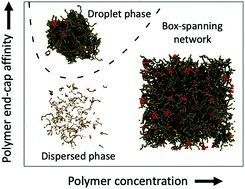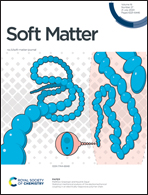Phase behaviour and structure of a model biomolecular condensate†
Abstract
Phase separation of immiscible fluids is a common phenomenon in polymer chemistry, and is recognized as an important mechanism by which cells compartmentalize their biochemical reactions. Biomolecular condensates are condensed fluid droplets in cells that form by liquid–liquid phase separation of intrinsically-disordered proteins. They have a wide range of functions and are associated with chronic neurodegenerative diseases in which they become pathologically rigid. However, it remains unclear how their material properties depend on the molecular structure of the proteins. Here we explore the phase behaviour and structure of a model biomolecular condensate composed of semi-flexible polymers with attractive end-caps using coarse-grained simulations. The model contains the minimal molecular features that are sufficient to observe liquid–liquid phase separation of soluble polymers into a porous, three-dimensional network in which their end-caps reversibly bind at junctions. The distance between connected junctions scales with the polymer length as a self-avoiding random walk over a wide range of concentration with a weak affinity-dependent prefactor. By contrast, the average number of polymers that meet at the junctions depends on the end-cap affinity but only weakly on the polymer length. The structured porosity of the condensed phase suggests a mechanism for cells to regulate biomolecular condensates. Protein interaction sites may be turned on or off to modulate the condensate's porosity and therefore the diffusion and interaction of additional proteins.



 Please wait while we load your content...
Please wait while we load your content...